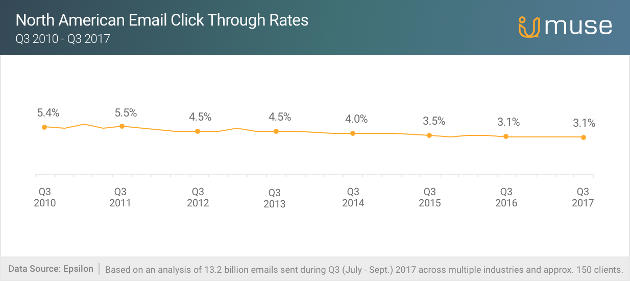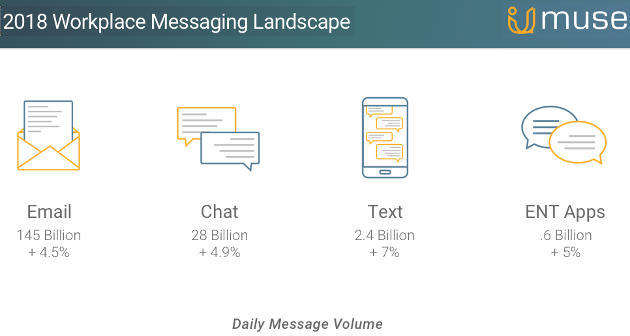Knowledge workers—marketers included—receive over 250 messages on average each day at work, with power communicators often seeing three times that number.
As message volume has increased, the amount of time we spend communicating has naturally gone up as well.
Workers who use email and chat spend over 3.25 hours on average per day in those applications.That's potentially 40% of your time that could be better spent elsewhere.
It's one thing to consider the impact of all those distractions on your marketing team's efficiency. It's another when those distractions start to impede your marketing campaign and program effectiveness. If your engagement numbers have been trending downward, you're not alone.
Unfortunately, when something has to give, often the first to suffer is your newsletter, product release email, or nurture campaign. But if you had more time to begin with—if your internal communications took up less of your time, say—you'd have more time to get those campaigns and emails out.
How We Communicate Today
To claim back some of that time and ensure your messages break through the clutter, it's important to understand how we're communicating today across various channels.
Chat and Text First
Workers are increasingly adopting chat and text, as well as filtering and prioritizing messages they receive via those channels. Most people read a text message within three minutes of receiving it, and chat takes slightly longer. By contrast, email is read within 1.9 hours, on average—and the longer it takes for recipients to read your email, the less likely you are to get a response. That doesn't mean email has become less valuable, but it does mean it's critical that your subject line stand out.
Message Prioritizations
For most of us, it started with the Gmail Promotions Tab. I remember thinking: "My email might go to something other than their inbox?!" But now, more and more tools are starting to prioritize or categorize messages for us. Office 365 released Focused Inbox, and Gmail recently added Nudge. Users are relying on the prioritization of these tools more and more, and therefore not necessarily seeing every message that comes into their inbox.

To learn more visit: https://umuse.io/.
Inner-Circle Preferences
We all have people we respond to faster than we do to others. Whether that's your boss or a subset of coworkers, social hierarchies influence communication. The growing popularity of chat at work reinforces the paradigm. With its single-stream message feed and lack of a formal file structure, chat users must pick and choose whom they respond to first, which means your messages must be consistently valuable and actionable, or you risk their never being seen.
How to Overcome the Clutter and Improve Your Marketing
With all that competition for attention, what's a marketer to do?
Invest in multi-channel
Seek multi-channel opportunities outside of email, and keep in mind they take time to build. Start now, and embrace each channel's unique style and etiquette—from in-app notifications to browser notifications, and from push notifications to SMS. Have a clear and appropriate use case for each type of communication, and confirm how users prefer to be reached.

To learn more visit: https://umuse.io/.
Make it fun (and brief!)
Chat uses 73% fewer words than email and relies heavily on emojis and gifs; it's highly conversational. Much of what users like about chat is its brevity—a trend that is likely going to stick. Conversational content delivered in easily digestible chunks will almost always better capture attention and elicit more meaningful responses.
Talk to real people
We've all learned the power of data, from A/B tests for emails and landing pages to targeted user surveys. But so many types of input can give one a false sense of confidence. Marketers know that you never really know how customers feel until you get out and talk to them in person. I'm continually amazed how generous and thoughtful customer feedback can be if you just bother to spend a little time to get it.
"That's great," you say, "but what if I'm unable to get work done myself at work?"
How to Improve Your Internal Communications
As marketers, we fixate on the success of our programs and campaigns. Yet it's also important to look at our own communication patterns and tools, and to strive to claim back some of those 3.25 hours per day lost in the process of trying to communicate.
Minimize tools and distractions
Marketers often use multiple communication tools, such as Asana, Basecamp, or Trello for project management; Slack, Stride, or Microsoft Teams for chat and collaboration; and Gmail, Outlook, or Office 365 for email. You can keep distractions from all those tools in check by forwarding all notifications to one application (say, email) and setting your preferences to notify you only of the most important messages.
Embrace the 3Ds
Email threads lend themselves more naturally to keeping conversations organized, while chat is unstructured and more meandering, making it easier for things to fall through the cracks. In both types of communication, however, I'm a big fan of the 3Ds: Do it, delegate it, or delete it—period. A ruthless adherence to that principle will help keep your messages and priorities in check.
Make rules, and stick to them
Keeping up with every message and alert as it comes in can be overwhelming. Instead, implement some rules and resist the urge to reply immediately. For chat, turn off group notifications, and for email, consider adding rules that move messages from VIPs into a separate folder so you can focus on those important messages first.
* * *
Does all this sound like a lot of work? It can be. But when you consider the time you can get back and the reduced drain on your productivity, isn't it all worth it?
To learn more about tools that can help you automate these techniques, check out umuse.io.




